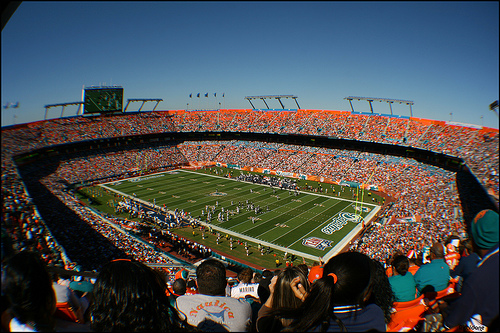
| AFC | NFC | PAST | FUTURE |
|
STADIUMS |
| Past |
| Future |
| FEATURES |
| Comparisons |
| Merchandise |
| Seating Charts |
| Stadium Videos |
| Super Bowl |
| Tickets |
| Travel Guide |
|
INFORMATION |
| Sitemap |
| Home |
 |
| Super Bowl Tickets |
| HOTELS |
|
Find Great Hotels near Dolphin Stadium Here! |
| POSTERS |
 Miami Dolphins Dolphin Stadium Signature Collection Poster by Highland Mint  Dolphin Stadium PhotoMint by Highland Mint Limited to 2,500  Dolphins at Dolphin Stadium by Rob Arra 13.5" x 39" Framed |
 Land
Shark Stadium
Land
Shark StadiumMiami, FL
When one thinks of cities that host the Super Bowl, Miami is one city that is likely to come to mind. This is because the city has hosted nine Super Bowls and will host its tenth, Super Bowl XLIV on February 7, 2010. In the late 1970s and early 1980s after playing at the Orange Bowl for several decades, Dolphins owner, Joe Robbie, began lobbying for a new stadium for his team. After voters continually rejected tax increases for a stadium to be built, Robbie decided build the stadium himself. After finding a site to build the stadium, construction began in December 1985. Construction costs for the facility were paid for by the selling of luxury suites, club seats, private funds and long term agreements with season ticket holders. The stadium was completed in under two years and originally named after Joe Robbie.
The Miami Dolphins played their first game at
Joe Robbie Stadium on August 16, 1987. Joe Robbie Stadium was a
major upgrade from the Orange Bowl. The state of the art facility
has 75,000 orange and teal seats that enclose the field. The
numerous many circular ramps and escalators make accessibility to any seat
very
easy. Two high-definition video boards are located above the rim of the upper deck
of each end zone. In 1990, in an effort to bring MLB baseball to
Florida, Wayne Huizenga purchased 50% of Joe Robbie Stadium. In 1991, MLB awarded
Miami
a team, the Florida Marlins, who began playing in 1993. Joe Robbie
Stadium now became a multipurpose facility. When the stadium
was built for the Dolphins, Joe Robbie insisted on a rectangular
grandstand layout that was wider than needed for football,
believing that baseball would one day come to Miami. The seats in
the lower level on the north side of the stadium become
retractable, so the field can be configured for baseball. The
first Florida Marlins game played at the stadium was on April 5,
1993. In 1996, Joe Robbie Stadium was renamed Pro Player Stadium,
after the company bought the naming rights to the stadiu m.
In January 2005, owner of the Dolphins, Wayne Huizenga, announced
that Pro Player Stadium would be renamed Dolphin Stadium. Huizenga also announced that the stadium would be renovated and
enlarged. To be completed in three phases over several years, the
project is expected to cost $300 million. The project includes
remodeling of the club level and luxury suites, new scoreboards
and additional parking by 2010.
In May
2009, the stadium's naming rights were bought by Land Shark Lager,
a beer that Jimmy Buffett markets in a deal with Anheuser-Busch.
The stadium name reverted back to Dolphin Stadium after the 2010
FedEx Orange Bowl. It has
been the host to two World Series in 1998 and 2003, and three
Super Bowls in 1989, 1995 and 1999. It is scheduled to host the
Super Bowl in 2010.
m.
In January 2005, owner of the Dolphins, Wayne Huizenga, announced
that Pro Player Stadium would be renamed Dolphin Stadium. Huizenga also announced that the stadium would be renovated and
enlarged. To be completed in three phases over several years, the
project is expected to cost $300 million. The project includes
remodeling of the club level and luxury suites, new scoreboards
and additional parking by 2010.
In May
2009, the stadium's naming rights were bought by Land Shark Lager,
a beer that Jimmy Buffett markets in a deal with Anheuser-Busch.
The stadium name reverted back to Dolphin Stadium after the 2010
FedEx Orange Bowl. It has
been the host to two World Series in 1998 and 2003, and three
Super Bowls in 1989, 1995 and 1999. It is scheduled to host the
Super Bowl in 2010.
|
||||||||||||||||||||||||||||||||||||||||||||||||
Copyright © 2001
-
Stadiums of Pro Football
is not associated with the National Football League or any team mentioned.
Contact Us with any problems or
errors on this page. This page may not be reproduced without permission from Stadiums of Pro Football.




